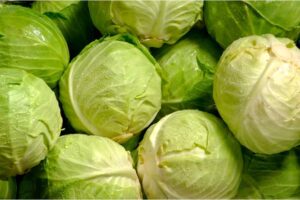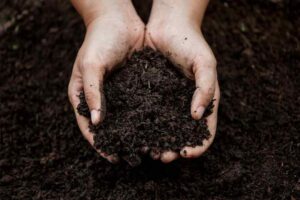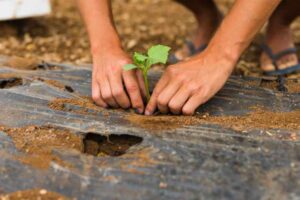
Cabbage is a popular vegetable that can be eaten raw, cooked, or used as an ingredient in salads, soups, and other dishes.
Growing cabbage from scraps is a great way to save money and reduce food waste. It’s also an easy and fun project that can be completed in just a few steps. With a few simple supplies and a bit of patience, you can grow a bountiful crop of cabbage from scraps. This guide will provide you with the information you need to do just that.
Benefits of Growing Cabbage from Scraps
Re-growing cabbage from scraps is an easy and efficient way to enjoy the many benefits of this unique vegetable. Not only is it a great way to save money, but it also allows you to have a never-ending supply of fresh, organic produce.
Cabbage is packed with nutrients such as vitamins C and K, as well as minerals like folate, manganese and potassium, making it an incredibly nutritious choice for your meals.
Additionally, cabbage is low in calories and full of fiber, making it a great choice for those who are watching their weight or trying to maintain a healthy lifestyle.
Finally, re-growing cabbage from scraps is a great way to reduce food waste and help the environment. So why not give it a try?
Enjoy the many benefits of growing cabbage from scraps and have a never-ending supply of fresh, organic produce in your kitchen.
Preparing the Scraps to Grow Cabbage
Growing cabbage can be a fun and rewarding experience. It is an easy-to-grow vegetable that thrives in cool weather and produces crunchy, nutritious leaves.
Preparing the soil for cabbage is an important step in ensuring a successful harvest. Before planting, the soil should be amended with compost or aged manure to provide the cabbage with essential nutrients.
It is also important to prepare the scraps for planting by removing any weeds and large rocks. This will help to create a healthy foundation for the cabbage to grow and develop.
Once the soil is ready, cabbage should be planted in a sunny, well-drained location and watered regularly. With the right preparation and care, you can enjoy a bountiful harvest of fresh, homegrown cabbage.
Planting the Cabbage Scraps
Planting cabbage scraps is a fun way to try regrowing cabbage from kitchen leftovers. You might not get a full-sized cabbage head from this method, but it’s a cool experiment, especially for kids, and you can get some small leaves that can be added to salads or other dishes. Here’s how to do it:
Regrowing Cabbage from Scraps
Materials:
- Cabbage scraps (the base or root end)
- A shallow bowl or dish
- Fresh water
- Potting soil
- A pot or container with drainage holes
Steps:
-
Preparation of Cabbage Scrap:
- Start by cutting off the base (or bottom) of the cabbage, leaving about 1-2 inches of the cabbage. This is the part you’ll be using to regrow.
-
Starting in Water:
- Place the cabbage base, cut side up, in a shallow bowl or dish.
- Add just enough water to cover the base of the cabbage, but not submerge it completely.
- Place the bowl in a sunny spot, like a windowsill.
- Change the water every 1-2 days to keep it fresh and prevent any bacterial growth.
- Within a week or so, you should start to see small roots and leaves beginning to sprout.
-
Transplanting to Soil:
- Once you see a good amount of roots and some new leaves, it’s time to plant your cabbage in soil.
- Fill a pot or container with potting soil, making sure it has drainage holes to prevent overwatering.
- Create a shallow hole in the center of the soil.
- Carefully place the cabbage base into the hole, burying the roots and the base but leaving the new growth exposed.
- Water the soil around the cabbage base, ensuring it’s moist but not waterlogged.
-
Care and Growth:
- Continue to keep the soil moist.
- Place the pot in a location with good sunlight.
- As the cabbage grows, you’ll see new leaves emerging from the center. The outer, older leaves may wither and can be removed.
-
Harvest:
- The cabbage is unlikely to grow a full-sized head using this method, but the young leaves can be harvested once they are a decent size.
- These leaves can be added to salads, stir-fries, or used as a garnish.
Tips:
- While the cabbage base can sprout new growth, the energy stored in the scrap is limited. This is one reason why a full cabbage head might not form. It’s more about enjoying the process and getting some bonus greens.
- Make sure to avoid letting the water go stagnant when starting the scraps in water, as this can cause rot.
- If you notice any mold or foul smell, it’s best to discard the scrap and start fresh.
Remember, regrowing cabbage and other veggies from scraps is an experiment, and results can vary. Enjoy the process and the satisfaction of giving new life to your kitchen leftovers!

Caring for the Cabbage Plant
Caring for the Cabbage Plant is essential in order to ensure a hearty harvest of healthy cabbages. With proper watering, fertilizing, and pest control, you can enjoy a bountiful crop of crunchy, nutritious vegetables.
Understanding the basics of caring for your cabbage plant will help you get the most out of your garden. Watering the plant regularly, fertilizing with the right nutrients, and keeping an eye out for pests are all key to keeping your cabbage plant healthy.
With a little love and care, you can enjoy a delicious, vitamin-packed harvest.
FAQs About the how to grow cabbage from scraps
Is it possible to regrow cabbage from scraps?
Answer: Yes, it is possible to regrow cabbage from scraps. All you need to do is cut the base off the cabbage head, leaving some of the outer leaves. Place the base in a bowl of water and wait for it to start sending out roots and new leaves.
How long does it take to regrow cabbage from scraps?
Answer: It usually takes about two to four weeks for a cabbage to regrow from scraps. The growth rate depends on the temperature and humidity of the environment.
What kind of soil is best for regrowing cabbage from scraps?
Answer: Rich, loamy soil with plenty of organic matter is best for growing cabbage from scraps. The soil should be moist but not soggy. Use a balanced fertilizer to provide the necessary nutrients for healthy growth.
Conclusion
Growing cabbage from scraps is a great way to produce a fresh and healthy vegetable for you and your family. All you need is a few cabbage scraps, some soil, some water, and a bit of patience. With a bit of care and attention, you can grow an abundant crop of cabbage in your own backyard or garden. Cabbage is an excellent source of vitamins and minerals, and is an easy way to add some variety to your diet. With the right knowledge and preparation, you can have a thriving cabbage patch in no time.








One Comment